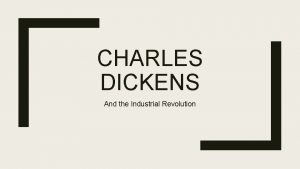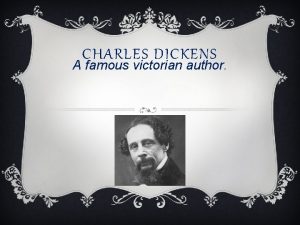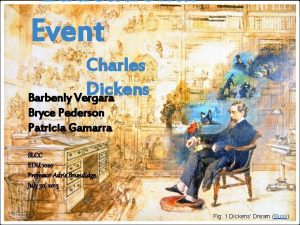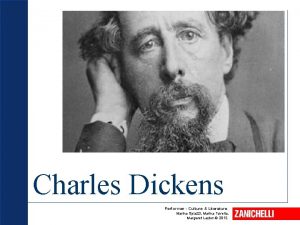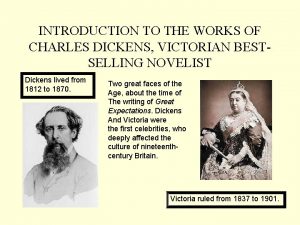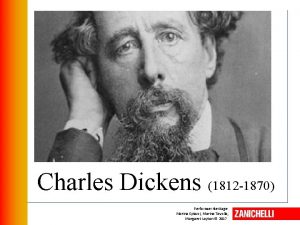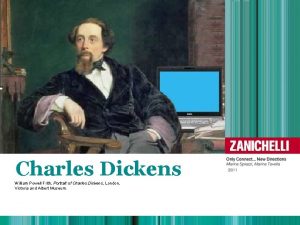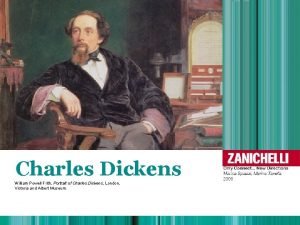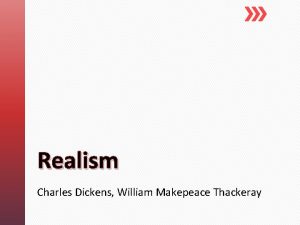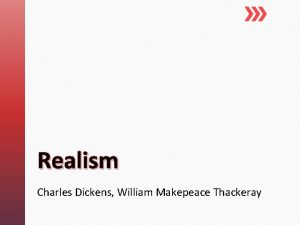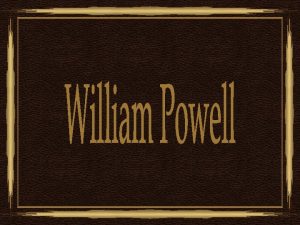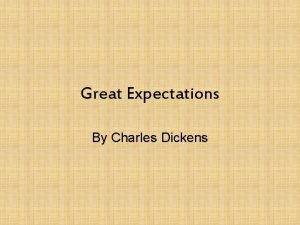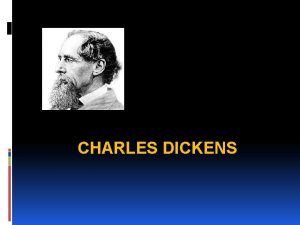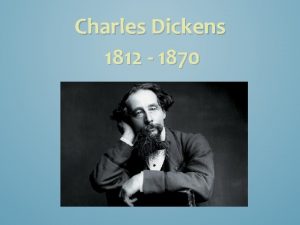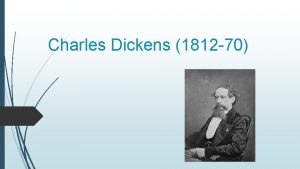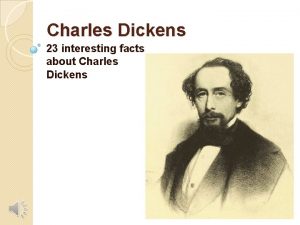Charles Dickens William Powell Frith Portrait of Charles
















- Slides: 16

Charles Dickens William Powell Frith, Portrait of Charles Dickens, London, Victoria and Albert Museum.

Charles Dickens 1. Dickens’s life • Born in Portsmouth in 1812. • Unhappy childhood: he had to work in a factory at the age of 12 (his father went to prison for debts). • He became a newspaper reporter with the pen name Boz. • In 1836 Sketches by Boz, articles about London people and scenes, were published in instalments. Evert A. Duyckinick, Charles Dickens The Prose and the Passion

Charles Dickens 1. Dickens’s life • Success with autobiographical novels, Oliver Twist (1838), David Copperfield (1849 -50), Little Dorrit (1857). • Bleak House (1853), Hard Times (1854), Great Expectations (1860 -61) set against the background of social issues. • Busy editor of magazines. • Died in 1870. Evert A. Duyckinick, Charles Dickens The Prose and the Passion

Charles Dickens 2. The setting of Dickens’s novels • Dickens was the great novelist of cities, especially London. • London is depicted at three different social levels: 1. the parochial world of the workhouses its inhabitants belong to the lower middle class. 2. the criminal world murderers, pickpockets living in squalid slums. 3. the Victorian middle class respectable people believing in human dignity. The Prose and the Passion

Charles Dickens 2. The setting of Dickens’s novels • Detailed description of “Seven Dials”, a notorious slum district its sense of disorientation and confinement is clearly expressed in Dickens’s novels Gustave Doré and Blanchard Jerrold, Dudley Street, Seven Dials from London: A Pilgrimage, 1872. The Prose and the Passion

Charles Dickens 3. Dickens’s characters Dickens shifted the social frontiers of the novel: the 18 thcentury realistic upper middleclass world was replaced by the one of the lower orders. He depicted Victorian society in all its variety, its richness and its squalor. An unfinished painting by R. W. Buss (1804 -75) variously known as A Souvenir of Dickens and Dickens’s Dream. Painted 1875. Charles Dickens Museum, London. The Prose and the Passion

Charles Dickens 3. Dickens’s characters He created: • caricatures he exaggerated and ridiculed peculiar social characteristics of the middle, lower and lowest classes • weak female characters He was on the side of the poor, the outcast, the working class. An unfinished painting by R. W. Buss (1804 -75) variously known as A Souvenir of Dickens and Dickens’s Dream. Painted 1875. Charles Dickens Museum, London. The Prose and the Passion

Charles Dickens 4. Dickens’s themes • Family, childhood and poverty the subjects to which he returned time and again. • Dickens’s children are either innocent or corrupted by adults. A scene from Roman Polanski’s Oliver Twist (2005) The Prose and the Passion

Charles Dickens 4. Dickens’s themes • Most of these children begin in negative circumstances and rise to happy endings which resolve the contradictions in their life created by the adult world. A scene from Roman Polanski’s Oliver Twist (2005) The Prose and the Passion

Charles Dickens 5. Dickens’s aim Dickens tried to get the common intelligence of the country to alleviate social sufferings. He was a campaigning novelist and his books highlight all the great Victorian controversies: • the faults of the legal system (Oliver Twist) • the horrors of factory employment (David Copperfield, Hard Times) • scandals in private schools (David Copperfield) The Prose and the Passion

Charles Dickens 5. Dickens’s aim Dickens tried to get the common intelligence of the country to alleviate social sufferings. He was a campaigning novelist and his books highlight all the great Victorian controversies: • the miseries of prostitution • the appalling living conditions in slums (Bleak House) • corruption in government (Bleak House) The Prose and the Passion

Charles Dickens 6. Dickens’s style very rich and original The main stylistic features of his novels are: 1. long list of objects and people; 2. adjectives used in pairs or in group of three and four; 3. several details, not strictly necessary. The Prose and the Passion

Charles Dickens 6. Dickens’s style very rich and original The main stylistic features of his novels are: 4. repetitions of the same word/s and/or sentence structure. 5. the same concept/s is/are expressed more than once, but with different words. 6. use of antithetical images in order to underline the characters’ features. The Prose and the Passion

Charles Dickens 6. Dickens’s style very rich and original The main stylistic features of his novels are: 7. exaggeration of the characters’ faults. 8. suspense at the end of the episodes or introduction of a sensational event to keep the readers’ interest. The Prose and the Passion

Charles Dickens 7. Hard Times (1854) It is a “denunciation novel” a powerful accusation of some of the negative effects of industrial society. The setting Coketown, an imaginary industrialised town. Characters people living and working in Coketown, like the protagonist Thomas Gradgrind, an educator who believes in facts and statistics. A contemporary edition of Hard Times The Prose and the Passion

Charles Dickens 7. Hard Times (1854) Themes: 1. a critic of materialism and Utilitarianism. 2. a denunciation of the ugliness and squalor of the new industrial age. 3. the gap between the rich and the poor. Aim to illustrate the dangers of allowing people to become like machines. A contemporary edition of Hard Times The Prose and the Passion
 Charles dickens biographical information
Charles dickens biographical information Charles dickens view on the industrial revolution
Charles dickens view on the industrial revolution Journey to niagara by charles dickens summary
Journey to niagara by charles dickens summary Relative pronouns charles dickens
Relative pronouns charles dickens Charles john huffan dickens
Charles john huffan dickens Christmas webquest
Christmas webquest Great expectations chapter 12
Great expectations chapter 12 Charles dickens outline
Charles dickens outline Charles dickens childhood facts
Charles dickens childhood facts Charles dickens song horrible histories
Charles dickens song horrible histories Charles dickens performer heritage 2
Charles dickens performer heritage 2 Charles dickens prezentace
Charles dickens prezentace Charles dickens victorian age
Charles dickens victorian age Lektira oliver twist
Lektira oliver twist English novelist charles
English novelist charles Plot oliver twist performer heritage
Plot oliver twist performer heritage Great expectations introduction
Great expectations introduction

